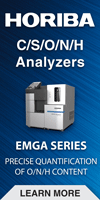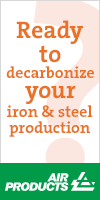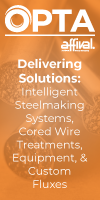Carpenter Technology Reports Strong Quarter, Sees Positive Signs of Growth
01/30/2014 - Carpenter Technology Corporation announced financial results for the quarter ended 31 December 2013.
Carpenter reported a net income of US$29.5 million or US$0.55 per diluted share, compared to US$33.0 million or US$0.62 per diluted share in the same quarter last year.
“Carpenter's second quarter earnings were consistent with our expectations,” said William A. Wulfsohn, president and chief executive officer. “The team demonstrated strong execution again this quarter. Share gains were realized in Transportation and Industrial & Consumer, which helped offset continued soft demand in our Aerospace business. Thus, while volume was up versus the prior year, our mix was weaker. Operationally, in our Specialty Alloys Operations (SAO) segment we continued to lower our production cost per ton.
“Looking forward, we are seeing positive signs of growth, as well as a gradual Aerospace and Energy demand recovery. We expect this recovery to gain momentum as we complete the second half of our fiscal year and enter fiscal year 2015. Our SAO segment experienced a significant increase in orders in the second quarter versus the same period last year. In addition, within our Performance Engineered Products (PEP) segment, we implemented numerous operational improvements and saw growing demand in our Energy businesses, both of which we expect to drive improved results in the third quarter and beyond.
“This week, we had our official ribbon cutting ceremony at our Athens facility. The project is ahead of schedule and on budget. After completing their audit, the Performance Review Institute (PRI) has recommended that the Athens facility receive AS9100 certification. The strong progress we have made starting up this facility gives us the opportunity to accelerate customer qualifications. One change to note is that, after further consideration, we have decided to use straight-line depreciation for the facility. As a result, we now expect the break-even point of the Athens facility, which has 27,000 tons of capacity, to be approximately 4,000 premium tons per year. This change will not impact our EBITDA.
“With over 80% of the spending on the Athens facility now completed, and with no need for further major capital expansions on the horizon, we expect to begin generating strong free cash flow by the fourth quarter of fiscal 2014. This cash flow, combined with our solid balance sheet, will give Carpenter the financial flexibility to drive increased shareholder returns.”
Net Sales and Operating Income
Net sales for the second quarter of fiscal year 2014 were US$503.5 million, and net sales excluding surcharge were US$414.6 million, a decrease of US$16.1 million (or 4%) from the same quarter last year, on 8% higher shipments. This sales decline can be attributed primarily to the continued soft demand in Aerospace and Energy. Volume was up due to increased share on key platforms in Transportation and Industrial & Consumer.
Operating income was US$47.5 million in the current quarter, a decrease of US$5.2 million from the prior year second quarter. Operating income—excluding pension earnings, interest and deferrals (EID)—was US$51.3 million, a decrease of US$9.4 million (or 15%) from the second quarter of the prior year. This reduction mainly reflects the sales mix impact, partially offset by improved manufacturing performance. The company made a correction to the amount of pension EID capitalized into inventory, resulting in a US$2.2 million increase to operating income.
Cash Flow
Cash flow from operations was US$7.0 million, which included US$60.9 million of increased working capital, and US$1.5 million of pension contributions. This compares to a cash flow from operations of US$38.9 million in the prior year’s second quarter, which includedUS$27.1 million of increased working capital, and US$9.8 million of pension contributions. The increased working capital in the current quarter was mainly driven by lower accounts payable as spending on the Athens facility begins to wind down. Free cash flow in the second quarter was negative US$99.9 million, compared to negative US$51.6 million in the same quarter last year. Capital spending in the second quarter, largely related to the construction of the Athens facility, was US$97.6 million, compared to US$80.5 million in the prior year’s second quarter. Approximately 80% of the project spend has occurred; the remaining 20% will occur over the next 18 months.
Total liquidity, including cash and available revolver balance, was US$598 million at the end of the second quarter. This consisted ofUS$106 million of cash, and US$492 million of available revolver.
End Markets
* Excludes sales through Carpenter’s distribution businesses
Aerospace and Defense
Beginning with the fiscal year 2014 first quarter results, the company changed its reportable segments. The company has two reportable segments, Specialty Alloys Operations (“SAO”) and Performance Engineered Products (“PEP”). The change reflects the completion of the integration of the businesses acquired by the company in the acquisition of Latrobe Specialty Metals, Inc. (“Latrobe”) in February 2012. Prior to this change, the Latrobe businesses were reported as a separate segment to provide management with the focus and visibility into the business of the acquired operations. The previously reported Latrobe segment also included the results of the company’s distribution business in Mexico. Since the Latrobe businesses are now fully integrated, the previously reported Latrobe segment has been merged into the company’s operating model, in which the company’s integrated steel mill operations are managed distinctly from the collection of other differentiated operations.
The SAO segment is comprised of Carpenter's major premium alloy and stainless steel manufacturing operations. This includes operations performed at mills primarily in Reading and Latrobe and surrounding areas in Pennsylvania, South Carolina, and the new premium products manufacturing facility being built in Limestone County, Ala.
The PEP segment is comprised of the company’s differentiated operations. This segment includes the Dynamet titanium business, the Carpenter Powder Products ("CPP") business, the Amega West business, the Specialty Steel Supply business and the Latrobe and Mexico distribution businesses. The businesses in the PEP segment are managed with an entrepreneurial structure to promote speed and flexibility, and drive overall revenue and profit growth. The pounds sold data above for the PEP segment includes only the Dynamet and CPP businesses.
The service cost component of net pension expense, which represents the estimated cost of future pension liabilities earned associated with active employees, is included in the operating results of the business segments. The residual net pension expense, or pension earning, interest and deferrals (pension EID), is comprised of the expected return on plan assets, interest costs on the projected benefit obligations of the plans, and amortization of actuarial gains and losses and prior service costs, is included under the heading "Pension earnings, interest & deferrals."
“Carpenter's second quarter earnings were consistent with our expectations,” said William A. Wulfsohn, president and chief executive officer. “The team demonstrated strong execution again this quarter. Share gains were realized in Transportation and Industrial & Consumer, which helped offset continued soft demand in our Aerospace business. Thus, while volume was up versus the prior year, our mix was weaker. Operationally, in our Specialty Alloys Operations (SAO) segment we continued to lower our production cost per ton.
“Looking forward, we are seeing positive signs of growth, as well as a gradual Aerospace and Energy demand recovery. We expect this recovery to gain momentum as we complete the second half of our fiscal year and enter fiscal year 2015. Our SAO segment experienced a significant increase in orders in the second quarter versus the same period last year. In addition, within our Performance Engineered Products (PEP) segment, we implemented numerous operational improvements and saw growing demand in our Energy businesses, both of which we expect to drive improved results in the third quarter and beyond.
“This week, we had our official ribbon cutting ceremony at our Athens facility. The project is ahead of schedule and on budget. After completing their audit, the Performance Review Institute (PRI) has recommended that the Athens facility receive AS9100 certification. The strong progress we have made starting up this facility gives us the opportunity to accelerate customer qualifications. One change to note is that, after further consideration, we have decided to use straight-line depreciation for the facility. As a result, we now expect the break-even point of the Athens facility, which has 27,000 tons of capacity, to be approximately 4,000 premium tons per year. This change will not impact our EBITDA.
“With over 80% of the spending on the Athens facility now completed, and with no need for further major capital expansions on the horizon, we expect to begin generating strong free cash flow by the fourth quarter of fiscal 2014. This cash flow, combined with our solid balance sheet, will give Carpenter the financial flexibility to drive increased shareholder returns.”
Net Sales and Operating Income
Net sales for the second quarter of fiscal year 2014 were US$503.5 million, and net sales excluding surcharge were US$414.6 million, a decrease of US$16.1 million (or 4%) from the same quarter last year, on 8% higher shipments. This sales decline can be attributed primarily to the continued soft demand in Aerospace and Energy. Volume was up due to increased share on key platforms in Transportation and Industrial & Consumer.
Operating income was US$47.5 million in the current quarter, a decrease of US$5.2 million from the prior year second quarter. Operating income—excluding pension earnings, interest and deferrals (EID)—was US$51.3 million, a decrease of US$9.4 million (or 15%) from the second quarter of the prior year. This reduction mainly reflects the sales mix impact, partially offset by improved manufacturing performance. The company made a correction to the amount of pension EID capitalized into inventory, resulting in a US$2.2 million increase to operating income.
Cash Flow
Cash flow from operations was US$7.0 million, which included US$60.9 million of increased working capital, and US$1.5 million of pension contributions. This compares to a cash flow from operations of US$38.9 million in the prior year’s second quarter, which includedUS$27.1 million of increased working capital, and US$9.8 million of pension contributions. The increased working capital in the current quarter was mainly driven by lower accounts payable as spending on the Athens facility begins to wind down. Free cash flow in the second quarter was negative US$99.9 million, compared to negative US$51.6 million in the same quarter last year. Capital spending in the second quarter, largely related to the construction of the Athens facility, was US$97.6 million, compared to US$80.5 million in the prior year’s second quarter. Approximately 80% of the project spend has occurred; the remaining 20% will occur over the next 18 months.
Total liquidity, including cash and available revolver balance, was US$598 million at the end of the second quarter. This consisted ofUS$106 million of cash, and US$492 million of available revolver.
End Markets
| Q2 FY14 | Q2 FY14 | Q2 FY14 | ||||
| Sales* | vs. | vs. | ||||
| Ex. Surcharge | Q2 FY13 | Q1 FY14 | ||||
| (in Millions) | ||||||
| Aerospace and Defense | $177.7 | -9% | -3% | |||
| Energy | $64.8 | -6% | +10% | |||
| Medical | $22.4 | -7% | -10% | |||
| Transportation | $28.4 | +17% | +11% | |||
| Industrial and Consumer | $88.9 | +4% | +4% | |||
Aerospace and Defense
- In calendar year 2013, Boeing delivered 648 planes, and Airbus delivered 626 planes, an increase of 9% and 6%, respectively, over 2012.
- Demand for engine materials is stabilizing, with future growth expected.
- Structural and fastener material sales were down, due largely to destocking in the supply chain, while order patterns indicate growth in the second half of fiscal year 2014.
- The directional rig count grew 4% versus the same quarter last year.
- Demand for oil and gas materials has stabilized and is expected to grow in the second half of fiscal year 2014.
- The power generation market is gaining momentum; Carpenter’s sales to this market segment in the second quarter increased versus the prior year.
- Volume is improving, but industry cost containment efforts continue to impact sales growth.
- Titanium prices remain low, which negatively impacts demand as distributors continue destocking.
- There has been strong build growth in North America—up 5% in calendar year 2013.
- Carpenter continues to benefit from strong demand growth for materials used in the newest engine platform fuel delivery systems, which are designed to meet CAFE standards.
- There has been strong demand for materials used in bridge infrastructure projects.
- Demand is also strengthening for materials used in plant and equipment applications.
Beginning with the fiscal year 2014 first quarter results, the company changed its reportable segments. The company has two reportable segments, Specialty Alloys Operations (“SAO”) and Performance Engineered Products (“PEP”). The change reflects the completion of the integration of the businesses acquired by the company in the acquisition of Latrobe Specialty Metals, Inc. (“Latrobe”) in February 2012. Prior to this change, the Latrobe businesses were reported as a separate segment to provide management with the focus and visibility into the business of the acquired operations. The previously reported Latrobe segment also included the results of the company’s distribution business in Mexico. Since the Latrobe businesses are now fully integrated, the previously reported Latrobe segment has been merged into the company’s operating model, in which the company’s integrated steel mill operations are managed distinctly from the collection of other differentiated operations.
The SAO segment is comprised of Carpenter's major premium alloy and stainless steel manufacturing operations. This includes operations performed at mills primarily in Reading and Latrobe and surrounding areas in Pennsylvania, South Carolina, and the new premium products manufacturing facility being built in Limestone County, Ala.
The PEP segment is comprised of the company’s differentiated operations. This segment includes the Dynamet titanium business, the Carpenter Powder Products ("CPP") business, the Amega West business, the Specialty Steel Supply business and the Latrobe and Mexico distribution businesses. The businesses in the PEP segment are managed with an entrepreneurial structure to promote speed and flexibility, and drive overall revenue and profit growth. The pounds sold data above for the PEP segment includes only the Dynamet and CPP businesses.
The service cost component of net pension expense, which represents the estimated cost of future pension liabilities earned associated with active employees, is included in the operating results of the business segments. The residual net pension expense, or pension earning, interest and deferrals (pension EID), is comprised of the expected return on plan assets, interest costs on the projected benefit obligations of the plans, and amortization of actuarial gains and losses and prior service costs, is included under the heading "Pension earnings, interest & deferrals."


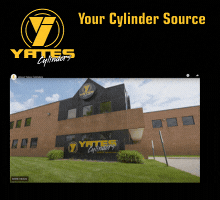
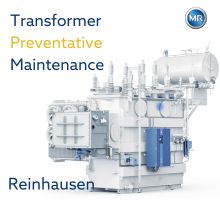-(220-x-200-px)-(130-x-130-px)-(220-x-200-px).jpg?lang=en-US&ext=.jpg)
Veolia.gif?width=200&height=200&mediaprotectionhash=4deca34a0d5a00013b5a0ccdc2dcf98fd2c17aabb57eb7bbb27200552f29c247&ext=.gif)
